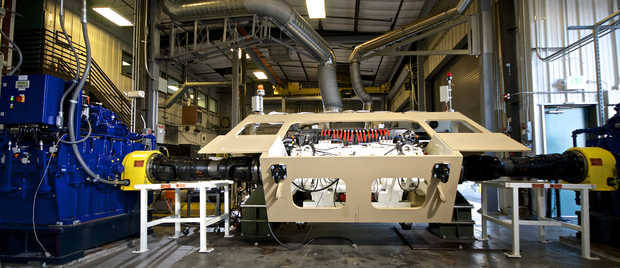BAE completed 2000-mile GCV hybrid mobility test ahead of time

First Ground Combat Vehicle (GED) with hybrid electric drive (HED) from BAE Systems successfully passed the 2000 miles test on the fully integrated mobile platform Hotbuck, which was an important milestone for the GCV program, led by the US Army.
Hotbuck is a stationary modern test bench that simulates real-life conditions and terrain and makes it possible to actually conduct a test run of the hybrid system. In accordance with BAE Systems' own tight schedule, the tests were completed four months earlier than the officially scheduled deadline.
"These tests are significant progress in the overall implementation of the GCV program. On real equipment, which allows us to demonstrate that the BAE Systems team can complete the schedule ahead of schedule both now and in the next phase of the program, saving the client time and money," said Mark Signorelli (Mark Signorelli), Vice President and General Manager for Armored Combat Systems at BAE Systems. "Our main goal was to test our hybrid electric technologies for a long time in a realistic environment, and the successful completion of the tests is a testament to the quality and maturity of the technology."
The development and testing of real equipment was not a requirement of the Technology Development (TD) program, but BAE Systems decided to take the initiative to demonstrate the fuel efficiency and other characteristics of the hybrid system for a promising army infantry fighting vehicle.
Hotbuck installed the hybrid electric drive (HED) components that will be used in the BAE Systems offer for GCV, including traction drive systems, thermal systems, motors, generators, controllers and software. Held at the BAE Systems plant in Santa Clara, California, the 2000-mile pre-test accurately reproduces the conditions that exist at two well-known military range ranges. The test results further confirmed the performance, efficiency and maturity of the HED technologies used in the GCV design of BAE Systems.
The HED system in GCV, which BAE System proposed will contribute to: - creating high torque at any speed, resulting in more flexibility, greater acceleration and greater maneuverability than machines with comparable mechanical systems - reduction in fuel consumption to 20 percent compared to what a GCV would have with a conventional power plant, which leads to a reduction in total costs and the required number of fuel convoy - the presence of sufficient electrical power on board, taking into account the increase in consumption with the introduction of new technologies in the next 30 - 40 years - a decrease in 40 percent of the total number of parts used than in comparable mechanical systems, which reduces maintenance requirements and reduces the life cycle cost of the machine
BAE Systems was awarded the contract for the TD stage of the GCV program in August 2011. The TD phase is scheduled to be completed by June 2014.
Information